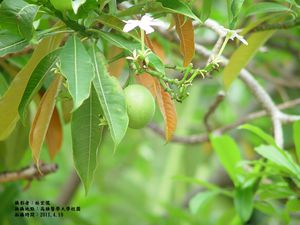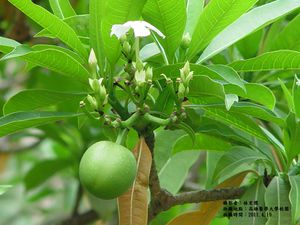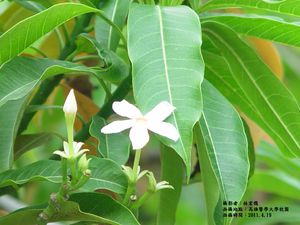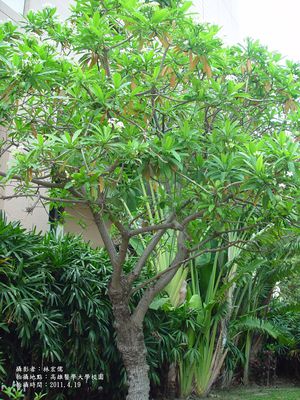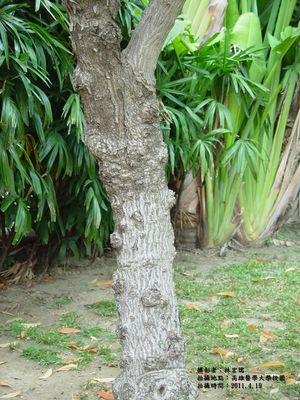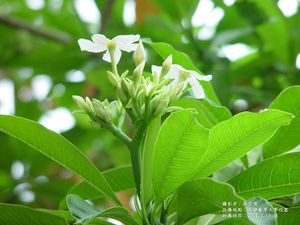海檬果
出自台灣有毒中草藥毒性資料庫
| 中英文學名 | 科別 | 毒性 | 症狀 |
基本資料[1]
|
科別 | 夾竹桃科 Apocynaceae |
|
屬名 | 海檬果屬 Cerbera |
|
中文學名 | 海檬果 |
|
拉丁學名 | Cerbera manghas L. |
|
英文名稱 | Odollam Cerberus-tree、pink-eyed cerbera、sea mango |
|
中文俗名 | 山檨仔、海檨仔、猴歡喜 |
植物圖片
|
海檬果果實及花1 |
海檬果果實、花2 |
海檬果花1 |
|
海檬果全株 |
海檬果樹幹 |
海檬果花2 |
海檬果簡介
海檬果為夾竹桃科海檬果屬的植物,又常被叫做海芒果,果實外觀與可食用的漆科芒果非常類似,但形狀比較圓,且科屬別也不同。海檬果與夾竹桃同為夾竹桃科,其根莖同樣含有白色乳汁,主要有毒成份為強心配醣體類化合物,對於心臟具有強烈毒性。主要產於熱帶和亞熱帶地區,國外多有案例報導[3, 4]指出食用後中毒,甚至死亡。由於海檬果具有漂亮的白色花朵,在台灣常被當作景觀樹栽植或是路樹[1]。
外觀簡述[1, 2]
|
莖 | 常綠小喬木植物,樹皮粗厚,樹枝分支硬直,葉痕非常明顯。 |
|
葉 | 單葉,具葉柄,柄長2-4公分。葉片長10-20公分,寬3-6公分,葉片呈倒卵形,葉基底漸尖或呈楔形,葉尖尖銳,葉緣全緣。上表面深綠色有光澤,葉背綠白色或淺綠色,葉側脈8-10對。 |
|
花 | 花序為頂生聚繖花序,花萼五裂,裂片呈披針形,容易脫落。花冠長漏斗形,白色,長1.5-3.5公分,花冠喉部淡紅色。雄蕊五枚,位於花冠下部,心皮兩枚,各含胚珠兩顆。 |
|
果實 | 核果,扁橢圓狀球形,先端微尖,內有紅色種子一粒。 |
產地
國外分布於中國、印度、緬甸、馬來西亞、菲律賓、琉球、澳洲等地。台灣主要分布於北部、東部及恆春半島與蘭嶼海岸[1]。
毒性研究
強心配醣體類化合物為非常知名的一種有毒成分分類,但仍可用於治療疾病,digoxin即為該類化合物成功應用於醫學治療的例子。雖然digoxin成功應用於醫療用途,但其治療窗非常的狹窄,治療劑量與中毒劑量非常接近,因此毒性可說是仍然相當的大。其餘屬於強心配醣體類的化合物也被研究發現與digoxin一樣具有會導致心律不整,嚴重甚至死亡的能力。強心配醣體類在American Association of Poison Control Centers (AAPCC)近十年(2000-2009)的年報[5-14]中也指出在美國境內自每年約有1500-2500人食入含有強心配醣體的植物而中毒。海檬果經研究分析具有相當帶有毒性的強心配醣體成分cerberin、neriifolin、cerberigenin[3, 15],有案例報導推測neriifolin可能是導致中毒者死亡的成分之一[3]。
- 症狀
強心配醣體類化合物最主要引起的中毒症狀為疲倦、腹瀉、嘔吐、高血鉀、高血鈣、低血鈉以及心律不整等問題[19]。在文獻報導的案例中,中毒患者所表現出的症狀除了前述所說的症狀外,也曾出現代謝性酸中毒、肌酸酐升高、臉色灰白、心搏過緩等表症[3, 4]。
- 毒性成份
由於屬於夾竹桃科植物,因此同樣含有強心配醣體類的毒性成分,文獻研究也證實海檬果主要有毒成分為cerberin、neriifolin、cerberigenin、carberoside、tanghinin等[3, 15, 20, 21]。Cerberin有研究指出在葉中的含量最高[20]。
- 毒性機轉
強心配醣體類的物質其作用機轉主要為抑制鈉-鉀三磷酸腺苷酶(Na+-K+ ATPase)[16-18]及影響鈉-鈣離子交換系統(Na+-Ca2+ exchange system)與電位-敏感性慢鈣離子管道(voltage-sensitivity slow calcium channel)的鈣離子平衡[16, 18, 19]。此種抑制作用,使得鉀離子無法排出心肌細胞外,造成高血鉀症狀,進而導致鈣離子堆積在心肌細胞內,造成高血鈣,且高量鈣離子會持續刺激心肌肌纖維收縮,因此產生陣發性心房心搏過速(paroxysmal atrial tachycardia),心房撲動(atrial flutter),心房顫動(atrial fibrillation),早熟性心室去極化(premature ventricular depolarization),心室顫動(ventricular fibrillation)等症狀,最嚴重可導致心搏停止[19]。
治療方式
海檬果所含的強心配醣體類化合物其結構與digitalis類似,因此有關海檬果中毒的病患,目前用於治療digitalis中毒的Fab fragment解毒劑也被試用於治療此類強心配醣體中毒[22]。另外,也使用atropine、phenytoin、活性碳、isoproterenol、sodium bicarbonate、magnesium及fructose-1,6-diphosphate等來對症治療[23, 24]。
毒性分級
參考文獻
[1] 鄭武燦. 台灣植物圖鑑 上冊. 台北: 茂昌圖書有限公司 2000.
[2] 台灣植物誌第二版編輯委員會. 台灣植物誌 第二版. In Edition 2. 台北: 台灣植物誌第二版編輯委員會.
[3] Maillaud C, Lefebvre S, Sebat C et al.Double lethal coconut crab (Birgus latro L.) poisoning. Toxicon 2010; 55: 81-86.
[4] Van Deusen SK, Birkhahn RH, Gaeta TJ. Treatment of Hyperkalemia in a Patient with Unrecognized Digitalis Toxicity. Clinical Toxicology 2003; 41: 373-376.
[5] Litovitz TL, Klein-Schwartz W, White S et al. 2000 Annual report of the American Association of Poison Control Centers Toxic Exposure Surveillance System. American Journal of Emergency Medicine 2001; 19: 337-395.
[6] Litovitz TL, Klein-Schwartz W, Rodgers GC, Jr. et al. 2001 Annual report of the American Association of Poison Control Centers Toxic Exposure Surveillance System. American Journal of Emergency Medicine 2002; 20: 391-452.
[7] Watson WA, Litovitz TL, Rodgers GC, Jr. et al. 2002 annual report of the American Association of Poison Control Centers Toxic Exposure Surveillance System. American Journal of Emergency Medicine 2003; 21: 353-421.
[8] Watson WA, Litovitz TL, Klein-Schwartz W et al. annual report of the American Association of Poison Control Centers Toxic Exposure Surveillance System. American Journal of Emergency Medicine 2004; 22: 335-404.
[9] Watson WA, Litovitz TL, Rodgers GC, Jr. et al. Annual report of the American Association of Poison Control Centers Toxic Exposure Surveillance System. American Journal of Emergency Medicine 2005; 23: 589-666.
[10] Lai MW, Klein-Schwartz W, Rodgers GC et al. 2005 Annual Report of the American Association of Poison Control Centers' national poisoning and exposure database. Clinical toxicology (Philadelphia, Pa.) 2006; 44: 803-932.
[11] Bronstein AC, Spyker DA, Cantilena LR et al. 2006 Annual Report of the American Association of Poison Control Centers' National Poison Data System (NPDS). Clinical toxicology (Philadelphia, Pa.) 2007; 45: 815-917.
[12] Bronstein AC, Spyker DA, Cantilena LR et al. 2007 Annual Report of the American Association of Poison Control Centers' National Poison Data System (NPDS): 25th Annual Report. Clinical toxicology (Philadelphia, Pa.) 2008; 46: 927-1057.
[13] Bronstein AC, Spyker DA, Cantilena LR, Jr. et al. Annual Report of the American Association of Poison Control Centers' National Poison Data System (NPDS): 26th Annual Report. Clinical toxicology (Philadelphia, Pa.) 2009; 47: 911-1084.
[14] Bronstein AC, Spyker DA, Cantilena LR, Jr. et al. 2009 Annual Report of the American Association of Poison Control Centers' National Poison Data System (NPDS): 27th Annual Report. Clinical toxicology (Philadelphia, Pa.) 2010; 48: 979-1178.
[15] Shen L-R, Jin S-M, Yin B-W et al. Chemical Constituents of Plants from the Genus Cerbera. Chemistry & Biodiversity 2007; 4: 1438-1449.
[16] Langer GA. Mechanism of action of the cardiac glycosides on the heart. Biochemical Pharmacology 1981; 30: 3261-3264.
[17] Matsui H, Schwartz A. Mechanism of cardiac glycoside inhibition of the (Na+-K+)-dependent ATPase from cardiac tissue. Biochimica et Biophysica Acta (BBA) - Enzymology 1968; 151: 655-663.
[18] Fozzard HA, Sheets MF. Cellular mechanism of action of cardiac glycosides. Journal of the American College of Cardiology 1985; 5: 10A-15A.
[19] Harvey RA, champe PC. Linppincott's Illstrated Reviews Pharmacology 台北: 藝軒圖書出版社 2002.
[20] Zhang XP, Pei YH, Liu MS et al. Chemical constituents from the leaves of Cerbera manghas. Asian Pacific Journal of Tropical Medicine 2010; 3: 109-111.
[21] Bond G, Baum H, Dimond G. Clinical observations with cerberin. American Heart Journal 1945; 30: 194-201.
[22] Eddleston M, Rajapakse S, Rajakanthan et al. Anti-digoxin Fab fragments in cardiotoxicity induced by ingestion of yellow oleander: a randomised controlled trial. Lancet 2000; 355: 967-972.
[23] 吳明玲. 毛地黃及動植物強心配醣體中毒之治療. In Edition 2002.
[24] Roberts DM, Buckley NA. Antidotes for acute cardenolide (cardiac glycoside) poisoning. Cochrane Database Syst Rev 2006; CD005490.
| 中英文學名 | 科別 | 毒性 | 症狀 |
